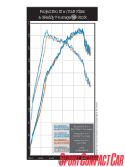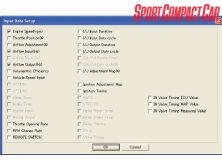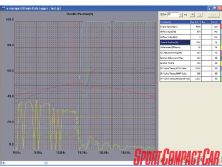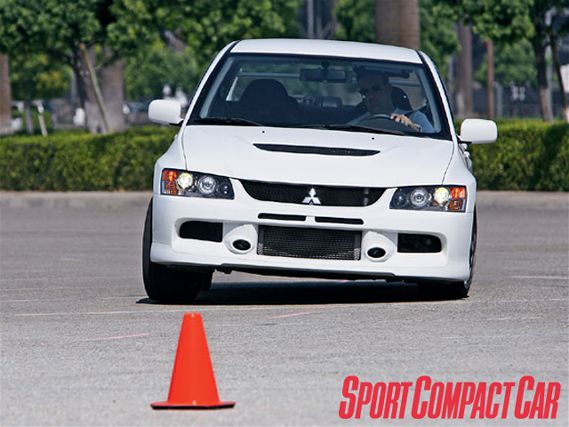 | Project EVO IX
| Project EVO IX
When we first decided to embark upon another Lancer Evolution project, we had to take a step back and think. The Evo is a fantastically fun car to drive, regardless of generation. It's blessed with quick-spool turbo power, loads of grip and an untapped potential just waiting to be unleashed. But the Evo is also well balanced from the factory and, like the Honda S2000, is easily corruptible with the wrong parts. So when we drew up the plans for our Evolution IX project, we knew we would have to have a game plan going in.
We wanted more than our mildly tuned red Evo VIII (our first Lancer Evolution project) delivered and we didn't want to go with a massive turbo like our old grey Evo VIII MR. No, the plan for Project Evo IX was to build a capable and fast street machine that still utilized the stock turbo, yet provided a wickedly fast driving experience. And some competition couldn't hurt either. We're going autocrossing.
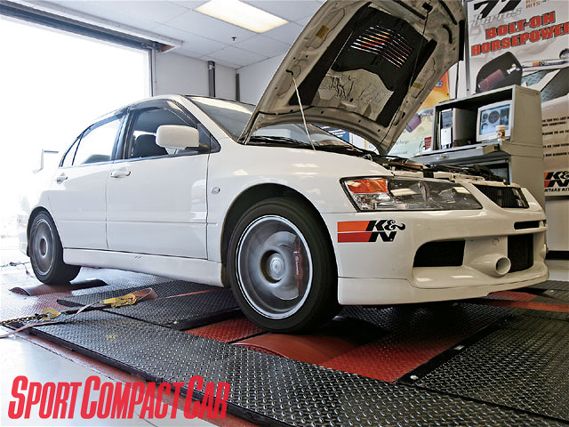 | Project EVO IX
| Project EVO IX
For those unfamiliar, autocrossing is an event where cars are timed as they run through a cone-lined course, which is usually set up in a generously sized parking lot. Cars are broken down by class, based on platform and modifications. Times between competitors usually split hairs based on tenths, if not hundredths, of a second. All that's needed to run is a helmet, four tires and a steering wheel. Autocross courses are tighter and smaller than typical road courses, which means lower speeds and the ability to be constantly at the limit of adhesion. The lower course speeds also mean less danger, nearly zero chance of rollover (although anything is possible if a driver is talented enough) and no need to worry about high-speed aerodynamics or instability. We're still going to take Project Evo IX out to a track day here and there, so there'll have to be some concessions made in terms of low- versus high-speed balance, and with heat dissipation in the brakes, but the primary focus will be on cone dodging.
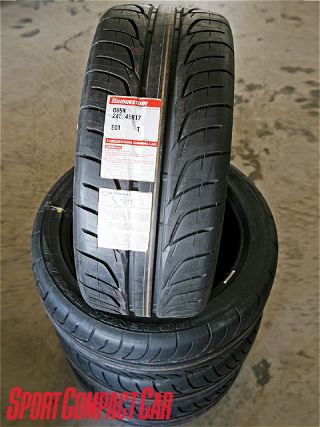 | Bridgestone's Extreme Performance Summer Potenza RE-01R (rated with a UTQG of 140/AA) is spreading through the street tire autocross ranks. We expect to battle STU on them.
| Bridgestone's Extreme Performance Summer Potenza RE-01R (rated with a UTQG of 140/AA) is spreading through the street tire autocross ranks. We expect to battle STU on them.
The first step to entering autocross events is finding out where the hell they take place. The Sports Car Club of America (SCCA) is the largest sanctioning body in the US. Unfortunately, they don't hold open track events for street cars in our region, like the National Auto Sport Association (NASA) HPDE program, but they do have the most detailed and structured autocross competitions around, known as Solo and ProSolo. ProSolo differs from the normal Solo autocross in that ProSolo is run head-to-head between two drivers using two mirrored courses. Both cars are sent off using a drag-style Christmas tree and the top times from each course are combined for each driver. The fastest Schumacher-esque cone masters at the end of competition are then run head-to-head in a series of extra 'challenge' events.
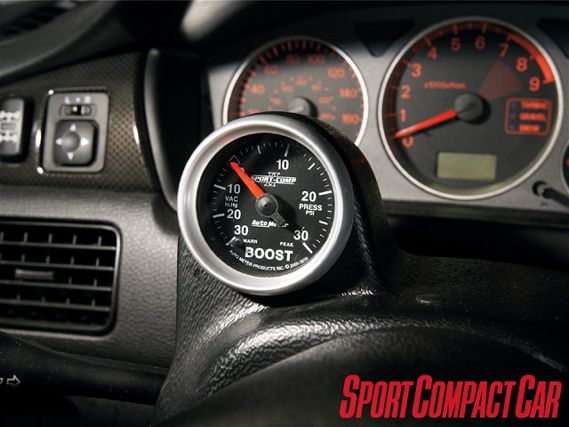 | Autometer's Sport-Comp II electric full-sweep gauges are brighter and easier to install than their old mechanical counterparts. A boost gauge isn't necessary right now, but we like one to keep an eye out for overboosting, which would signal a mechanical problem.
| Autometer's Sport-Comp II electric full-sweep gauges are brighter and easier to install than their old mechanical counterparts. A boost gauge isn't necessary right now, but we like one to keep an eye out for overboosting, which would signal a mechanical problem.
One cruise through SCCA's website will track down your local regional SCCA car club, which will feature the calendar of events in your area. Some regions run events that require SCCA membership and some don't. Our local events currently don't require SCCA membership to run, but to accrue points and compete at the Tire Rack SCCA Solo National Championships, membership and dues are required. A course walk, which is exactly what it sounds like, is done once or twice a day, but the glory of autocross is its ability to force you to learn course recognition and adaptation in just a few runs. Drivers such as World Challenge competitor Randy Pobst and Formula Drift pilot Calvin Wan got their start driving around cones in mall parking lots and, hey, if it worked for them, it's got to be worth a set of tires or two.
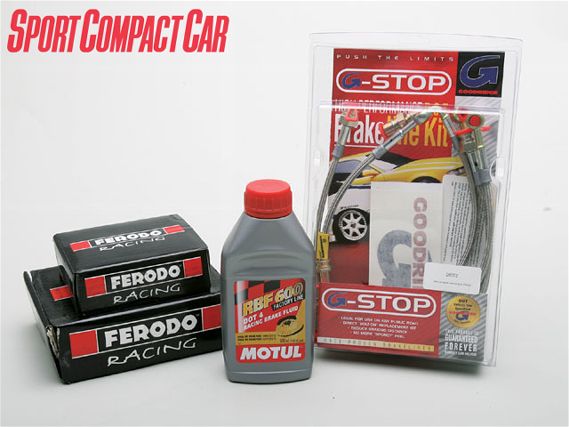 | The only brake parts any normal Evo owner will ever need: better pads, Goodridge lines and Motul fluid.
| The only brake parts any normal Evo owner will ever need: better pads, Goodridge lines and Motul fluid.
In contrast to a two-hour drive to the racetrack, our local autocross events only require a quick half-hour blast down the freeway and often have a semblance of civilization nearby. So they give the perfect battleground to run a street tire-shod project car that doesn't require a tire swap after arriving. We will no doubt become embroiled in the downward spiral of stiffer springs, triple-digit octane and race tires, but for now, we just want to get our foundation straight. Our aim is the Street Touring U (STU) class.
STU rules allow pump gas only, auxiliary gauges, racing seats (seat and bracket must weight 25 pounds), body kits, 245-width tires for all-wheel-drive cars, the use of only one high-flow cat, eight-inch wide wheels, reprogrammed ECUs (but no increase in boost), urethane bushings, camber kits, coilovers, anti-roll bars, turbo-back exhausts and brake pads. The cars are limited to 3.1 liters of engine displacement for forced induction cars and are unlimited for naturally aspirated machines. But before you go and build a stroker Evo motor, Street Touring rules specifically forbid built engines and engine swaps. Popular cars in STU include the Evo VIII, Evo IX, E36 M3, RX-8, Mustang, Camaro, Neon SRT-4 and WRX STI.
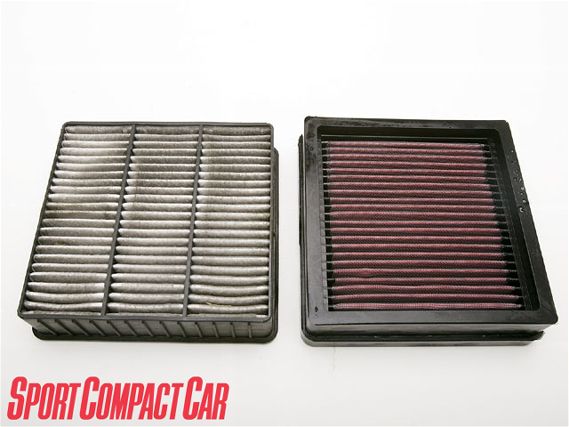 | The K&N air filter (right) is a simple five-minute install and blows away the flow capability of the stock paper unit (left). Plus, it's washable and reusable.
| The K&N air filter (right) is a simple five-minute install and blows away the flow capability of the stock paper unit (left). Plus, it's washable and reusable.
With the Lancer Evolution IX wearing 17x8 Enkei wheels straight from the factory, we knew we'd be in good shape for STU. We could have gone with an 18x8 wheel and eliminated the extra squish of tire sidewall flex, but didn't feel our hard-earned cash was worth the benefit, if any. Our piggy banks are staying locked until 9.5-inch wide wheels and 265-width tires find their way under our Evo's fenders. We'll be tackling the whole issue of unsprung weight and rotational mass versus eating top ramen in a future test article, but for now, we're just left dreaming about which bitchin' forged gems we'd get to match this car.
The stock Yokohama A046 tires lasted almost 20,000 miles and two track weekends before showing cords, which is apparently a pretty decent amount of time for an Evo. We've heard of some cars running out of tread in as little as 12,000 miles. With a tire this soft and sticky from the factory, we knew we couldn't go for a drop in quality. Looking through the entrant list for our local events, there seemed to be two tires used predominantly on front-running cars, the Yokohama Advan Neova and the Bridgestone Potenza RE-01R. Having already experienced the Neova on an Evo VI in our October 2007 issue cover story, we decided to sample the other variety and went with the RE-01R in the widest STU-allowed size that could fit an Evo: 245/45/17.
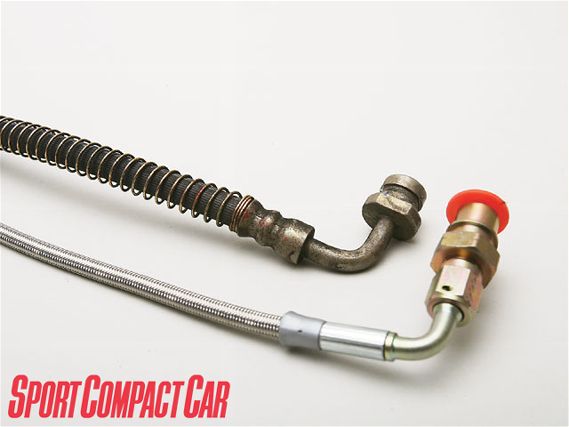 | Project EVO IX
| Project EVO IX
Bridgestone's RE-01R features a semi-slick shoulder block, large tread blocks, sculpted water evacuation channels and a wide center rib. Once the RE-01Rs hit the pavement, we were impressed. The tire delivers loads of grip and, most importantly, plenty of feedback in quick transitions. It obviously doesn't have the heat capacity of a race tire, but it's an excellent street tire that works well in autocross situations, where there is plenty of cooling time between runs.
The stock Evo brake line is well designed for a factory piece, with this spiral outer line to protect from damage, but it doesn't have the consistent feel and expansion resistance of the Goodridge.
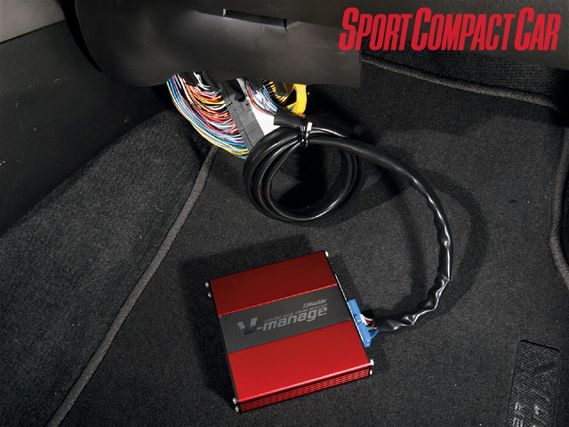 | Using the included plug-and-play harness, the GReddy V-manage is installed in line with the ECU and intercepts the factory intake valve timing signal.
| Using the included plug-and-play harness, the GReddy V-manage is installed in line with the ECU and intercepts the factory intake valve timing signal.
With new sticky rubber mounted, it was time to address the brakes. The Evo IX is blessed with a highly capable set-up, featuring four-piston fixed Brembo calipers up front (with 12.6-inch rotors) and two-piston fixed Brembos out back (with 11.8-inch rotors). They do a good job of stopping all 3260 pounds of the Evo IX's mass, but the stock brake pad feel is far from adequate. We're sure Mitsubishi engineers designed a special brake backing plate that could accept chopped and formed cardboard, because the stock pads seem to have no initial bite at all. In any situation, to slow a stock Evo, mash the middle pedal all the way down and keep it there, with no modulation to speak of. It's like having an on/off switch for brakes.
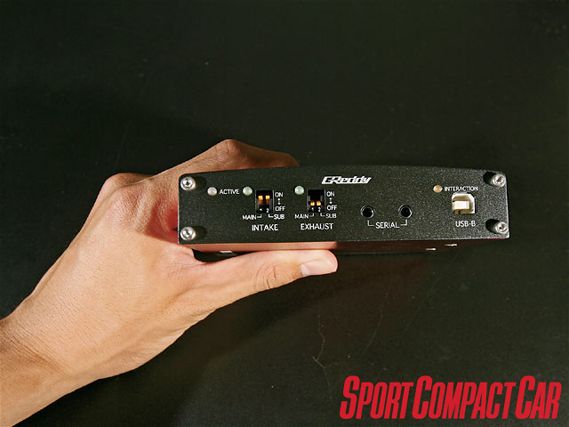 | With the MIVEC system, only intake valve timing is adjusted, so the exhaust control on the V-manage is left off. On other systems, such as the Subaru AVCS, both intake and exhaust variable valve timing can be adjusted.
| With the MIVEC system, only intake valve timing is adjusted, so the exhaust control on the V-manage is left off. On other systems, such as the Subaru AVCS, both intake and exhaust variable valve timing can be adjusted.
We swapped in a set of Ferodo DS2500 brake pads and the difference was dramatic. These are the pads Mitsubishi should have included from the factory. A good street-tire pad, the DS2500 provides extra bite and feel, and has a higher heat capacity range than stock. This is important to us because we'll be using our Evo IX at NASA HPDE days as well as autocross events. To that end, we also threw on a set of Goodridge stainless steel braided brake lines and then bled the system with Motul RBF600 brake fluid. The Goodridge lines are simple, direct-fit factory replacement pieces that give a much more consistent pedal feel during track days. Combined with the high boiling point of the RBF600 fluid, the Goodridge lines allowed us to go through an entire weekend with a hard, solid brake pedal where before we'd be bleeding our brakes trackside after just a couple of lapping sessions.
Although we have an 80mm GReddy SP2 street exhaust waiting to go on, we have yet to touch the engine in Project Evo IX. So we figured this was as good a time as any to try out a few stock engine tricks. After seeing too many aftermarket intakes run into air turbulence issues through the MAF, we decided to keep the stock intake box in place. We used a simple K&N Engineering drop-in panel filter and saw a peak horsepower gain of four wheel-hp and a peak torque loss of 0.5lb-ft from our baseline of 253.5 wheel-hp and 247lb-ft. We did, however, see a gain of 7.8lb-ft lower down, at about 4200rpm. The K&N filter won't give that bypass valve whoosh, but it will give you a car that can run past 300 wheel-hp with no driveability issues from the intake. We'll take that any day.
SCCA Solo rules part 14.10, E, #5 state that "VTEC controllers and other devices may be used which alter the timing of factory standard electronic variable valve timing systems." While you won't see any 'powered by VTEC' stickers on the back of Project Evo IX, there is a MIVEC badge on the valve cover. MIVEC, which stands for Mitsubishi Innovative Valve timing Electronic Control system, is the Evo IX's variable intake cam phasing system. By altering the intake cam phasing and the resultant effect on overlap, Mitsubishi engineers were able to increase low-end power and boost response compared to the Evo VIII, without any loss of driveability.
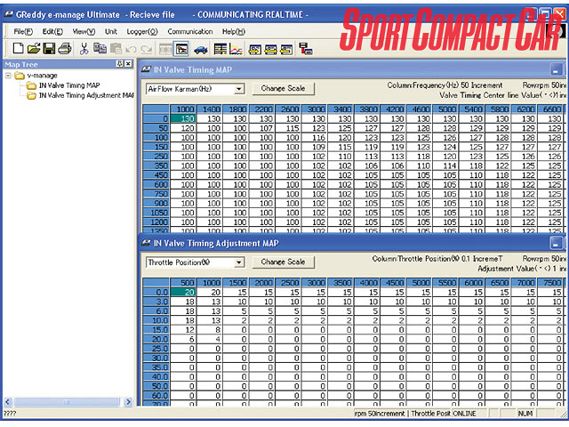 | With the included V-manage software, you can view intake valve timing in real time and make adjustments based on engine load and revs.
| With the included V-manage software, you can view intake valve timing in real time and make adjustments based on engine load and revs.
GReddy recently released a new line-up of plug-and-play V-manage variable valve timing ECUs, and we installed one in all of three minutes. GReddy sells the V-manage as a kit, which includes a dummy-proof jumper harness and a pre-programmed V-manage ECU. Tuned in-house at GReddy for compatibility with USDM Evo IXs, the V-manage also includes software so that you can use a laptop to create your own valve timing program, based on engine load and revs. The V-manage doesn't have the ability to alter timing or fuel, that's what GReddy's E-manage and E-manage Ultimate are for, but the stock pre-programmed map is designed to work with most stock turbo Evo IXs. We drove GReddy's own Evo IX, which was equipped with a full titanium exhaust and a V-manage unit. Low-end gains were very noticeable, using the almighty ass-dyno, especially from 2500rpm and up.
Another interesting feature of the V-manage is its data logging. Once hooked up to a laptop, the V-manage software can sample data every 20ms and can record and save logged files. Possible sampled data includes rpm, throttle position, airflow adjustment percentage, airflow input and output, intake valve timing values, ignition timing, vehicle speed, and more. The required USB cable isn't included, but it's an easy purchase at any electronics store.
On the dyno, the V-manage managed (no pun intended) to coax out 3.3 wheel-hp and 6.1lb-ft of torque peak, using the stock paper filter. Once we put the K&N air filter back in, peak gains jumped up to 7.9 wheel-hp and 10.4lb-ft with the extra air. Most importantly, the combination of V-manage and K&N filter helped make 19 wheel-hp and 30.7lb-ft of torque at a very usable 3300rpm. We expect a V-manage will show even more gains with a turbo-back exhaust, a new set of cams, an increase in boost, and custom tuning.
With just a few choice mods, we've laid the foundation for our autocrossing all-wheel-drive machine. Next, we'll take Project Evo IX to the track for testing and then get down to the dirty business of putting together a lower, stiffer suspension that works properly.

